#occult symbolism
Text

SP3KTR
74 notes
·
View notes
Text
A Dictionary of Alchemical Symbols
I was super flattered by all the positive comments and tags on my post about FMA:B’s alchemical symbolism. People seemed interested in learning more about alchemy, so I thought I’d post this here. This list is mostly paraphrased from A Dictionary of Alchemical Imagery by Lyndy Abraham, which is my main source. Brace yourselves, this will be long. (Disclaimer: The names and order of alchemical processes changes depending on the source. It’s a cyclical process, not a linear process. So I’m guessing at the order of the procedures.)
Abyss: Another name for Prima Materia, Chaos or the formless primordial matter from which the Stone is made.
Air: The androgynous, volatile, combined masculine and feminine principles. Its properties are hot and wet.
Alabaster: The White Stone, the material at the second stage of the work that can transmute metals into silver. It is purified and spiritual matter, body and soul (but not spirit yet).
Amber: Considered synonymous with gold, the product of the philosophical tree that represents the Philosopher’s Stone.
Androgyne: Mercurius and the Philosopher’s Stone, a union of male and female principles (i.e. Sun and Moon, sulfur and mercury, red and white), It is a synthesis of the hot, dry male aspect and the cold, wet female aspect. It represents the integration of male and female energies. It is therefore a union of opposites and a perfect being. It is sometimes represented by (red) roses and (white) lilies, which are symbols of the Red and White Tinctures. The symbol for Mercury (the planet) contains the symbols for both the sun and the moon, making it hermaphroditic. (Also called a rebis.)
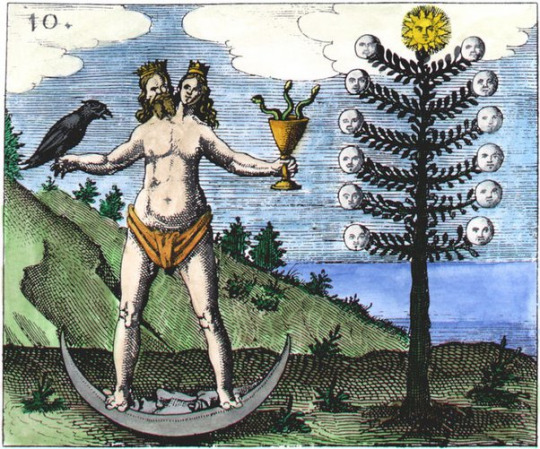
From Rosarium Philosophorum, redesigned by Johann Daniel Mylius
Angel: The volatile, spiritual, subtle matter of the Stone during sublimation.
Antimony: The substance of the Stone during the nigredo, black earth, the next stage up from lead.
Apollo: Represents the Red Tincture. The masculine principle, hot and dry, the rubedo stage.
Apple: The golden apple represents the fixing power of Sulphur on the elusive Mercury (represented by Atalanta).
Aqua ardens: “Burning water,” the universal solvent that dissolves matter into prima materia. Represented by Mercury.
Aqua regia: “Royal water,” a mixture of nitric acid and hydrochloric acid (sal ammoniac) that can dissolve gold and platinum. That makes it a form of the mercurial “burning water” that can reduce all metal to prima materia.
Aqua vitae: Ethanol, specifically distilled wine. It’s also a name for Mercury and for Quintessence, the catalyst of the work that “washes” the matter of the Stone to purify and whiten it. It’s the “water of life” that resurrects the dead matter, the essence of love and forgiveness.
Argent vive: Quicksilver, actual mercury (Hg), the feminine “seed” of metals that must be “married” to its masculine counterpart, sulfur.
Ash: The remains of the body when the subtle self (the soul) is removed during calcination. It is the white powder that the body becomes during the white stage, which is washed in mercurial water and tempered with fire. A phoenix rises from the ashes.
Autumn: The completion of the Great Work is symbolized by the philosophical tree bearing its gold and silver fruit. Trees bear fruit in autumn, making autumn the season of culmination.
Balm: A term for the Philosopher’s Stone in the form of a panacea, a medicine that can purify anything and cure any disease (including spiritual ones)
Basilisk: Mercury in its negative aspect, it represents endless hunger and self-absorption. It is the mercurial water in its destructive aspect, which “kills” base metal, reducing it to prima materia.
Bath: The mercurial waters of purification, which dissolves, cleanses, and resurrects the matter of the Stone. The breaking down and washing away of an old state of being, leading to rebirth; baptism.
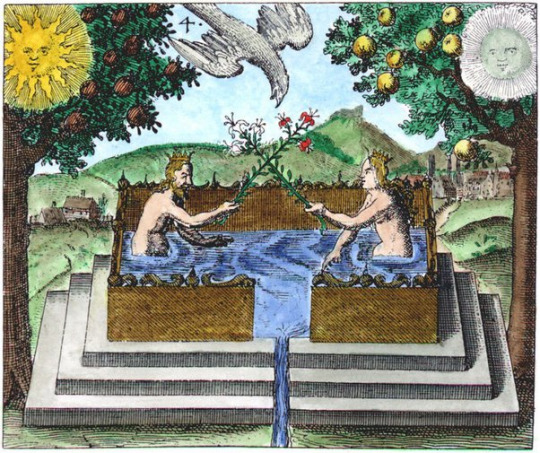
From Philosophia Reformata by Johann Daniel Mylius
Battles: Between a god and a dragon, or two dragons, or an eagle and a snake, a lion and a winged lioness, or similar; represent the alchemical lovers (Sol and Luna) in their impure state, as the “quarrelling couple.” Their fighting represents the violent chemical reactions that result of trying to force together the opposing forces of sulfur and mercury (or of the four elements), but eventually they reconcile and are married.

By Johann Daniel Mylius
Bed: The alchemical vessel during the “chemical wedding” stage.
Bee: Another symbol of the “mercurial serpent,” universal solvent. Its sting is a version of “killing” metals, destroying the old state of being. (Bees also transmute base matter in their process of creating honey.)
Beheading: The dismemberment of the King, the dissolution stage, leading to putrefaction and nigredo. It frees the soul from the body, so it can gain spiritual understanding. (The 8th engraving in The Ninth Gate.)
Binding: Binding Mercurius with cords represents fixation of the volatile, controlling the elusive and wily spirit of Mercurius so that he will help the alchemist. Nailing a serpent to a cross means the same thing.
Birds (flying): Represent volatile substances—vapors, fumes, spirits, souls, rising to the top of the alembic and falling as rain during the ablution stage.
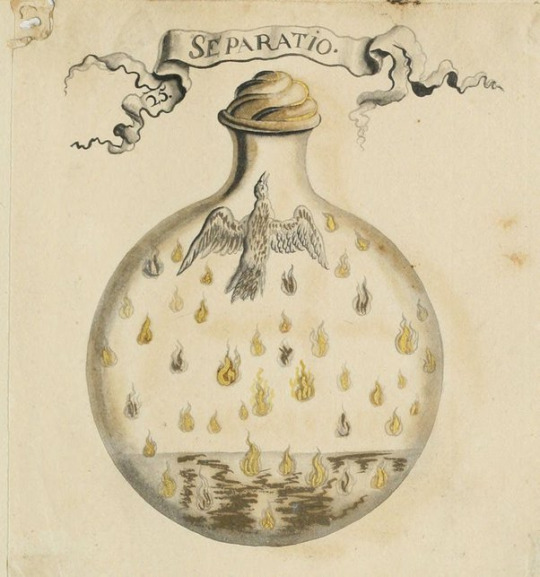
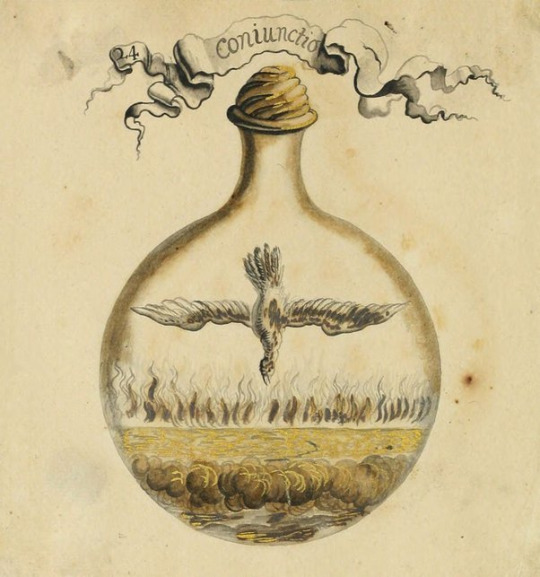
From The Crowning of Nature
Birds of Prey: The “amorous” birds of prey are a particularly violent symbol of the Chemical Wedding, the uniting of substances. They simultaneously copulate and cannibalize each other. Consumption represents taking the essence of the consumed into oneself, such as in communion or in the ouroboros symbol.
Bird of Hermes: A symbol of the Philosopher’s Stone, which must be hatched from an egg produced by the Chemical Wedding, raised, and tamed. It eats its own wings, representing the fixation of the volatile (i.e. it can no longer fly upwards). Its blood is the Elixir of Life.
Black: The nigredo, the death of the old state of being and the mortification of the body that paves the way for renewal and resurrection. The matter of the Stone during the nigredo is called “black earth,” and it lies at the bottom of the alembic. The soul descends into the Underworld and experiences the Dark Night of the Soul, and all the difficulty and pain that come with it. Symbolized by the crow or raven, the grave or tomb, the eclipse, beheading, coal, lead, and Saturn.
Blood: A symbol of the Red Tincture, the Philosopher’s Stone. If a “pure” being sheds blood, it cleanses “impure” beings of corruption. It is also the mercurial water that washes the matter of the Stone during ablution. The blood of the Green Lion nourishes the Stone during cibation. Staining white sheets with red blood (i.e. as in the loss of virginity, the gaining of sexual maturity) represents the rubedo following albedo.
Bronze/Brass: Both represent “white gold” (gold + silver), the raw matter of the Stone which must be cleansed of impurities. Identified with Latona (Leto), the mother of Apollo and Artemis (i.e. the sun and moon), and also with the Green Lion. It must have its “stains” washed away to become Gold and Silver (respectively).
Caduceus: The wand of Hermes, symbolizing the circulation of male and female energies (the serpents), and their reconciliation. The wand unifies them, and they entwine around it. Harmonizing unification of all opposites.
Calcination: Stage One. Heating the base metal to ash. This represents removing all the surface qualities of the self, putting oneself through “purifying fires” until one is reduced to prima materia. Self-judgement, acknowledging that you are not perfect, with a desire and determination to do better. Burn away the old self.
Castle: The alchemical vessel, sealed to prevent the substance of the Stone from being contaminated by outside forces, and to keep the volatile part from escaping. Its towers represent the athanor (furnace). The castle can also represent “impure” matter (i.e. the Green Lion, Latona). Also represents withdrawing to the inner self.
Chaos: The formless matter from which the world was made, the mass of prima materia at the beginning of the universe that contains all things, and from which all things come. The extremely dense ball of matter that was the universe until the Big Bang. Chaos is separated into the Four Elements, which are then united with each other in harmony.
Chariot of Phaethon: A name for the Great Work. This is because the Opus is cyclical like the wheels of a chariot and the sun’s course through the heavens. When Phaethon dies, Helios mourns in the form of an eclipse, representing the nigredo.
Chemical Wedding: The image of lovers, usually a king and queen representing the sun and moon, being married or having sex. One of the most important parts of the Work, the unification of opposites — sulfur and mercury, male and female, sun and moon, hot and cold, dry and moist, fixed and volatile, body and spirit. The lovers are wedded by Mercurius, the mediating principle who binds them together. The chemical wedding happens multiple times, becoming more “purified” each time – it begins as animals mating, and ends as the noble royal wedding of the King and Queen. The resulting Stone is the essence of pure divine love. Coagula is always followed by solve again, so often the lovers are shown in a coffin or grave, because the nigredo follows the chemical wedding. After that happens, soul and spirit unite in the albedo stage, and then they reunite with the now washed and purified body in the rubedo stage. Body dissolves into spirit, spirit coagulates into matter. Therefore, the knowledge gained from union with spirit (God) can be actively applied and made manifest in the physical world.
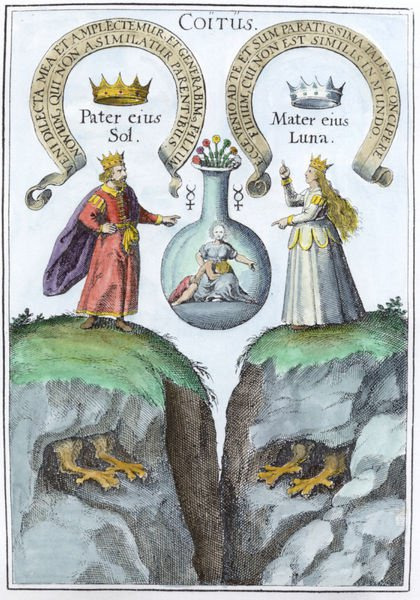
By Johann Daniel Mylius
Child: The Philosopher’s Stone when it is born from the chemical wedding of the Sun and Moon. He gestates in the belly of the wind, i.e. the soul in the volatile state. When he is brought to Earth and nourished, he grows up to be a spiritual tour-de-force that can raise the vibration of anything.
Child’s play: Another metaphor for the Opus, because the process is subversive, and because it’s stupidly simple once you actually understand how it works. The Opus is compared to making mud pies by pouring water on dust and then making “solid” objects with the resulting mud.
Cibation: Stage Seven. The newborn Stone is “fed” the White and Red Tincture, “milk and meat,” which are added to the vessel to re-infuse the Stone with life energy.
Cinnabar: Mercury sulfide (ore), which is bright red. Represents the color of the Stone in the final stages.
Circle: Perfection and eternity, the spiritual realm, the completed Work. With a dot in the center, it symbolizes gold.
Cloud: The vapor that rises to the top of the vessel during sublimation, the volatile state. The cloud is dark and made of argent vive (quicksilver), eclipsing the sun. During distillation, the cloud condenses into rain, which “washes” the stone during ablution.
Coal: Represents the nigredo, the black stage, the dead matter of the Stone.
Congelation: Fixation, crystallization, or freezing, the conversion of liquid into a solid state. Fixing the volatile spirit.
Conjunction: Steady, level heating of the mixture. Represents reconciling the polarized self, the first step towards integration of the Shadow. The “sacred marriage” or “chemical wedding” between mercury and sulfur unites them back into the same whole. Unification of opposites. The darkness becomes conscious. Coming to terms with oneself, self-acceptance, integration.
Copper: Metal that is almost perfect, but not quite. The state of being nearest to Gold; gold that still has a bit of darkness on it. It is still impure and not quite fixed. Once it “becomes shadowless,” it is Gold. Symbolized by Venus.
Coral: Represents the Red Stone, which grows in the mercurial water as coral lives in the ocean. Also represents the philosophical tree.
Cream: The white stage, albedo. After the chemical wedding, the souls of the dead king and queen rise to the top of the vessel the same way cream rises to the top.
Crocodile: The Mercurial Serpent in its most base and chthonic state, when it is dark and destructive.
Cross: A combination of the “passive” (horizontal line) and “active” (vertical line) forces of the feminine and masculine (respectively). Therefore, the synthesis of the male and female principles and the resulting unity of the volatile and the fixed. Also the four elements (clockwise from top: fire, air, earth, water) and Quintessence, the central point. (The hexagram has identical symbolism, being a combination of the signs for all four elements.)
Crow: The putrefaction stage, the nigredo or black stage that begins the work. The matter of the Stone is dissolved into prima materia and dies, so that it can be reborn.
Crown: A symbol of the spiritual perfection of the completed Philosopher’s Stone, which is represented as a king. The crown is a representation of the halo of light around the head of an enlightened person. The loftiness of alchemy is presented in regal terms – alchemy is called “the royal art,” gold the “noble metal,” and the final union of the male and female principles is the “royal wedding” between the philosophical King and Queen.
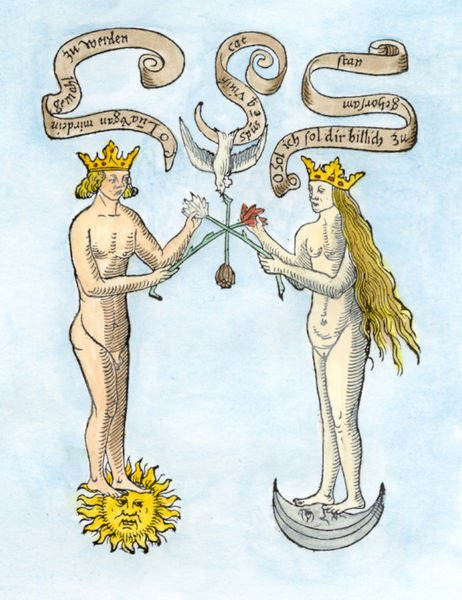
From the Rosarium Philosophorum
Crystal: A synonym for the Philosopher’s Stone at both the white and the red stage. Crystallization is also a word for coagulation, fixing the volatile.
Cupid: Another name for Mercurius in the form of “secret fire” or “burning water.” Cupid’s arrows of passion represent the universal solvent that reduces all substances to prima materia. The essence of love in the arrows refers to the higher nature of the Stone/elixir. Also a symbol of Mercurius as the mediator in the Chemical Wedding, who marries Sol and Luna.
Dawn: Represents the albedo stage, because the light of dawn is pale like moonlight, and it is followed by the blazing risen sun that represents the rubedo stage.
Decoction: Heating an ore or mineral, also extraction of the liquid essence of a substance by boiling.
Death: The nigredo stage of the Opus, during which soul is separated from the body and the body putrefies or is dissolved. Represents unenlightened consciousness and the rejection of the mundane self, being freed from the confines of one’s earthly body. An alchemist must metaphorically cast off the mortal coil without physically dying. Death is like a gate on a circlular path. You have to go through the gate, or you will never be able to continue around the circle. You’ll just stay stuck in place. To become immortal and continue forever around the circle, you must die, and cannot fear death.

From the Twelve Keys of Basil Valentine
Deer: Represents the soul. The “fleeing hart” represents Mercurius, specifically the flightiness of Mercurius, and also his role as the messenger and mediator between body and spirit. He is both a faithful servant (i.e. “servus/cervus,” deer) and an elusive and deceptive enigma that must be captured by the alchemist. According to Paracelsus, its antlers heal wounds.
Den: A word for the vessel during the nigredo — the serpent’s or dragon’s den, or spirits’ den.
Devil: A symbol of sulfur.
Devour: If animals or people devour each other, it usually represents an opposing state overcoming the other — such as the volatile (a winged creature) overcoming the fixed (the other animal), Saturn devouring the divine (mercurial) child, etc. Devouring is often a representation of solve, one substance or state being consumed by the other, but it’s also coagula in that it unites the fixed and volatile. The animals can also represent the earthly nature of man being destroyed. Something must die for a newer and purer thing to exist. Sometimes devouring is a metaphor for sex, a particularly violent rendition of the chemical wedding. It’s violent to symbolize the intense opposition of the substances.
Dew/Rain: The healing aspect of mercurial water. The blackened, putrefied matter of the Stone is washed in the dew and turns white (ablution). The dew falls like rain from the celestial spheres and reanimates the dead matter. “It ascends from the earth to the heaven and again it descends to the earth.” Precedes the second chemical wedding, when the purified soul is reunited with the body.
Diana: The matter of the Stone in the white stage, the White Tincture, the female principle, argent vive.
Dissolution: Stage Two. Dissolving the powder in (mercurial) water made from the condensed vapours from calcination. This represents self-awareness, dissolving your prejudices and old patterns, understanding the psychological roots of your behaviors. The first stage of Shadow work. Returning to the Abyss, the primordial waters, again and again and again. Purification by water.
Distillation and Sublimation: Stage Five. The process in which the volatile spirit is extracted from the impure body. It vaporizes (sublimates) and then condenses. Metaphysically, it’s katabasis, the necessary descent of the soul into base matter – “the way down is the way up.” You can’t ascend without having descended first. What Goes Down Must Come Up.
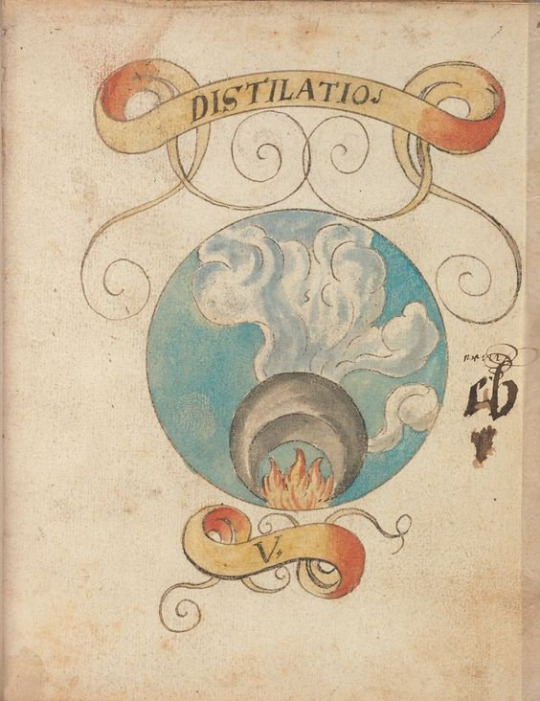
From The Crowning of Nature
Dog: A male dog represents sulfur while a female dog represents quicksilver. Two dogs having sex represents the most “primitive” form of the Chemical Wedding (which can also be represented by copulating dragons or lions).
Dove: A symbol of the albedo, the white stage, and purity following corruption. Also a symbol of Mercurius as the mediating force in the Chemical Wedding, uniting the forces of sulfur and quicksilver.
Dragon: Mercurius in his chthonic aspect as prima materia. Two dragons, one winged and one wingless, represent quicksilver and sulfur (respectively). They copulate, then kill and devour each other, then are entwined together around the caduceus in unity. Mercurial water is called “dragon’s blood” in its aspect as a universal solvent. It is the dragon that guards its horde of gold in the Abyss of a cave .The dragon represents the “base” self that the higher self must tame, represented by the dragon being slain by a solar hero (Apollo, Marduk, Siegfried, Beowulf, Harry Potter, etc.).

From The Ripley Scroll
Dregs: The impurities of the Stone that are left behind during dissolution and sublimation, that sink to the bottom of the vessel.
Dust: The purified body of the Stone during the albedo stage, which collects on the sides of the vessel through sublimation. (Also called ash, snow, or white foliated earth.)
Dye: A metaphor for the white stone turning red or purple. The Stone is “washed” in the Red Tincture, like dying cloth. Tyrian purple in particular is a metaphor for eternal spiritual perfection, because it is a permanent dye and rare. The Stone being stained with blood is the same metaphor.
Eagle: The White Tincture, another symbol of Mercurius during the albedo stage after sublimation. When paired with the lion, the lion represents the fixed state and the eagle represents the volatile state — if the eagle devours the lion, it’s a symbol of solve. The lion is devoured by the eagle to make it spiritual, and the eagle’s wings are clipped to make it corporeal.
Earth: Corporeality, the physical world, stagnation, fixation. The dense body of the Stone, represented by Saturn. (We live in the physical world, so the other elements are not their “true” selves, but perceived as correspondences that symbolize their true selves “through” the Earth element. It allows the other elements to “rest.”) Its properties are cold and dry.
East and West: Respectively, sulfur and quicksilver. Sulfur is dry and hot, quicksilver is cold and moist.
Eclipse: The solar eclipse represents the nigredo, when the impure matter of the Stone putrefies, death preceding rebirth. Described as a “black gate” that sulfur and quicksilver must pass through. The moon “dissolves” the sun. Symbolized by the Green Lion devouring the sun. (Also called sol niger. For the lunar eclipse, see sun and shadow)

From Philosophia Reformata, by Johann Daniel Mylius.
Egg: The vessel. Hatching of an egg is a metaphor for the creation of the Stone. The fire of the athanor is like a mother bird incubating her eggs.
Elements: Earth, Air, Fire, and Water. The Philosopher’s Stone must be made of all four elements in the right amounts to produce the perfect fifth element, Quintessence. Earth is cold and dry, Water is cold and wet, Air is hot and wet, and Fire is hot and dry. Earth can be mixed with water because they are both cold, Water can mix with Air because they are both wet, and then Air can mix with Fire because they are both hot.
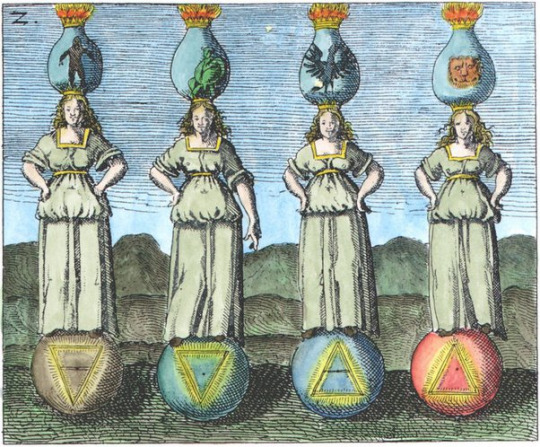
From the Viridarium chymicum
Elysium: A name for the white stage, a pure and beautiful garden of symbolic plants that immediately follows death.
Eyes: The rainbow “peacock’s tail” stage between nigredo and albedo.
Exaltation: Stage Eight. The material turns red, with all of its components fusing into one whole and becoming stable in the most intense heat of the furnace. The Stone has appeared. Once the ecstasy peaks, the body, soul, and spirit permanently fuse. Also called Fixation.
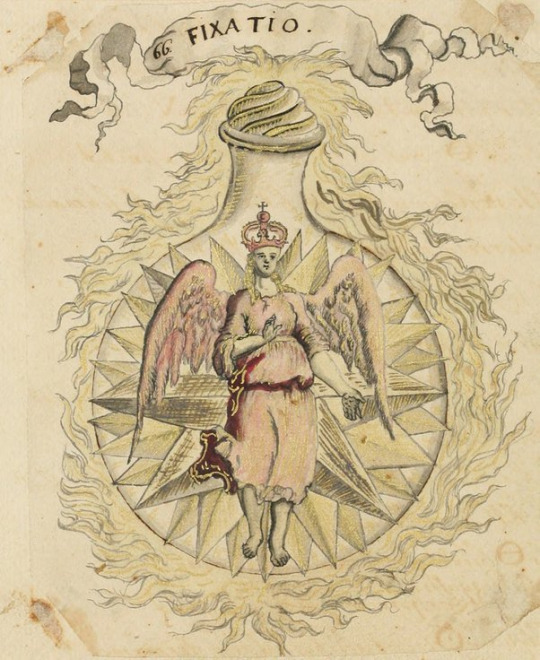
From The Crowning of Nature
Feathers: A bird eating its feathers symbolizes the dissolution that occurs after the chemical wedding (also symbolized by a child playing in a bath), Also a symbol of the “peacock’s tail” stage.
Fermentation: Stage Six. Permanently infusing life force into dead matter. The spiritual and base aspects of the self are united, and one is freed from superficial or “worldly” desires and concerns. The enzymes that cause fermentation represent the soul “quickening” the body. The material turns yellow and becomes gold. Add some gold to it to facilitate this change, like putting seeds into the earth. “Intoxicated surrender to one’s true inner self” (Richard Cavendish), seething emotions and ecstasy.
Field: Potential, the potential to “cultivate” the philosopher’s stone, in which the “seed” of the soul is sewn to be transformed into its realized potential, the flower. This happens through the course of the seasons—winter (black), spring (clear/white), summer (red), and autumn (gold).
Fire: The element, the essence of divine love, which causes transmutation. It is hot and dry, and inherently spiritual, a sort of microcosm of the Sun. The “secret fire” is purifying and transformative. The heat and intensity of the fire in the athanor increases as the Work progresses through the stages. Also represents the Divine Masculine. Symbolized by the Sun and Gold. In its impure form, as sulfur, fire is also individualization and the ego, which becomes consuming and desirous. Often conflated with mercurial water/argent vive, which “burns” and dissolves things.
Flood: Dissolution and putrefaction, with Noah’s Arc or a similar boat symbolizing the Vessel. The waters of the deluge drown and destroy everything, until they suddenly transform into the waters of life. The rainbow that follows the Flood is the Peacock’s Tail.
Flowers: Fully realized potential, resurrection, exaltation, rising from the depths of the Earth. (The stem is virile, the flower itself is elemental.) The rose in particular has mostly the same symbolism as the cross. Also a word for the powdery version of the body that is a result of sublimation. Also a symbol of the Philosopher’s Stone, the perfect substance. Flowers bloom as a result of Earth, Water (rain), and Fire (sunlight). White roses or lilies symbolize the albedo, golden flowers symbolize citrinitas, and red roses symbolize the rubedo.
Fountain: Purifying mercurial water, that generates all other metals. Same symbolism as the bath.
Fruit: Raw gold before it is transmuted into the Philosopher’s Stone. If the fruit putrefies in the ground, then its seeds will sprout into new trees. The Philosophical Tree bears gold and silver fruit representing the Sun and Moon. Bearing the fruit is a symbol of increasing spiritual awareness, and eating the fruit represents gaining that spiritual knowledge. Sometimes the golden fruit is specifically the Apples of the Hesperides, guarded by the dragon.

From Compendium Alchemyst by Johann Michael Faust
Furnace: The athanor in which the alembic or Vessel is heated. It contains “philosophical fire” (the soul), which purifies the matter in the Vessel. It causes suffering but also removes impurities. You have to suffer in the fire to be cleansed, and rise from it like the phoenix.
Garden: The Vessel, in which the philosophical tree grows. Sometimes also a rose garden, with red and white roses. The blooming of the roses represents the attainment of spiritual wisdom.
Glass: The Vessel. When the alchemical couple (Sol and Luna, or sulfur and quicksilver) die and enter the putrefaction stage, they are “shut in a glass.” The vessel can be symbolized as a glass house, glass prison, or glass coffin. Making glass is also a metaphor for the fixation process, because the volatile liquid crystallizes into hard glass.
Glue: The medium by which Sol and Luna are joined together during conjunction, that which officiates their Chemical Wedding. A form of Mercurius, the mediating soul that unites the body and spirit. Usually symbolized as a dove. Also symbolized as gum or resin from the philosophical tree.
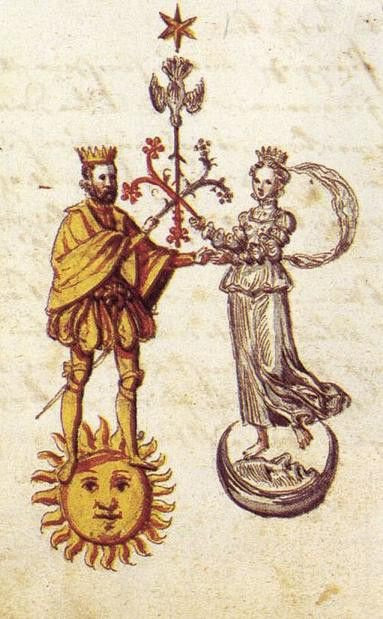
From the Rosarium Philosophorum
Gold: A pure, condensed form of the solar force and the Divine Masculine, and the ultimate goal of alchemy, representing spiritual perfection. It is the microcosmic Sun. It can “endure the trials of fire” (i.e. it has a low boiling point). All metals were thought to contain the potential to “ripen” into it, under the right conditions. Figuratively, this means that all people have the potential to become pure spiritual beings. The golden soul is one that has died and been resurrected as a purer thing, whose spirit has become fixed, and who has therefore attained a kind of earthly divinity.
Golden Fleece: A symbol of the Philosopher’s Stone. The quest for the golden fleece represents the alchemists’ quest for the Stone. Also a term for a supposed book made of sheep vellum that details all the secrets of the Great Work.
Grain: A term for the “seed” of metals, which grows into Sol and Luna (gold and silver). The Stone is also compared to grain or corn that has to “die” before it can bear fruit. “Purple grain” is the Red Tincture.
Grapes: Prima materia, the raw material of the Stone. Grape juice or wine represents the mercurial water of dissolution. A grapevine can also represent the philosophical tree, with the red fruit being the Philosopher’s Stone.
Grave: The Vessel during the nigredo stage, when the matter of the stone dies and putrefies. The dead bodies of the alchemical lovers are shown in a tomb or coffin.
Green: The color of the maturing Stone, after it has been born. It is the color of fertility and growth, so it represents the Stone’s capability to multiply itself and cause the “seeds” of metals to “mature” into gold and silver. It also represents the generation of the Stone after the Chemical Wedding.
Green Lion: Raw antimony ore (stibnite), “unclean” or “impure” material of the Philosopher’s Stone. Prima materia at the earliest stage of the Opus. The volatile mercury (spirit) is extracted from it. Associated with Latona (Leto, from whom Apollo and Diana as the Sun and Moon are born). It is green because the vital essence of fecundity comes from it, but also because it is an early and “immature” form of the Stone (like unripe fruit). Represents Mercurius in its form as a solvent: the lion eats the Sun, causing the nigredo and dissolution. After it is dissolved into prima materia, the “seed” can grow. The Green Lion also represents Mercurius as the “glue” that marries the Sun and Moon.
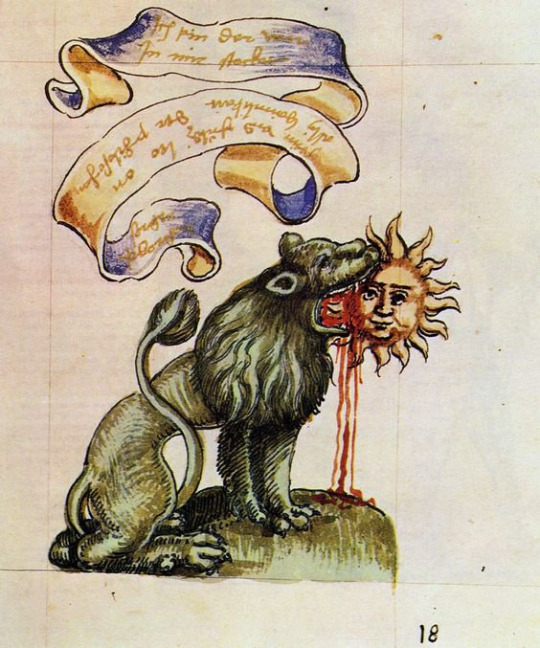
From the Rosarium Philosophorum
Griffin: A symbol of argent vive/quicksilver, the female principle. The feminine equivalent of the red lion. They fight each other, symbolizing the Chemical Wedding at its most early stage. (Combines the volatile eagle with the earthly lion.)
Halcyon (Kingfisher): A symbol for philosophical mercury, which is supposed to be sky blue. It is a universal solvent, able to destroy and then revitalize anything.
Harvest: The completion of the Opus and attainment of the Stone. The Great Work is often compared to the cultivation of a tree or a flower.
Head: The vessel or alembic, also symbolized by a helm. The vessel itself is a metaphor for the human body, and the real transmutation takes place in one’s head (i.e. mind). A person with black feet, a white body, and a red head is a symbol of the Opus. A severed head is a symbol of nigredo and dissolution, the separation of the soul from the body.
Heaven: The subtle matter of the Stone, the volatile vapor at the top of the alembic (as opposed to the “white foliated earth” at the bottom). “It ascends from the earth to the heaven and again it descends to the earth.” Quintessence is also called “heaven” because it is a perfect substance and it is bright blue.
Hell: The black matter of the Stone during the putrefaction stage, which is destroyed by fire (or “secret fire,” mercurial water). This stage is the descent into the Underworld or Tartarus.
Hermes’ Seal: The seal made of a special clay that keeps the alchemical vessel closed and airtight. The sealed vessel functions as an isolated cave or sanctuary in which one can seek enlightenment.
Hermes’ Tree: The philosophical tree, which must be tended by the alchemist and nourished with mercurial waters and then harvested. Another symbol for the Philosopher’s Stone.

From Philosophia Reformata, by Johann Daniel Mylius
Hermes Trismegistus: The legendary inventor of alchemy, said to be an incarnation of both Hermes and Thoth. Called “thrice-great” because he was a king, a mage, and a priest. Said to have written the Emerald Tablet and the Corpus Hermeticum.
Hesperides: The garden in which the philosophical tree grows. The Golden Apples of the Hesperides are another symbol for the Philosopher’s Stone.
Homunculus: An artificial human created in an alembic. Also a symbol of the Philosopher’s Stone in its infantile state. Represents the birth of the divine child inside one’s own soul. The Stone is figuratively a “baby” that must be gestated and raised, both in the alembic and spiritually in one’s soul. (i.e. You are reproducing God’s creation of yourself in a microcosm.)
Honey: Another name of mercurial water, in its aspect as a healing agent instead of a “burning” solvent. A symbol of the Elixir of Life and the panacea, because it is a sweet gold liquid.
House: The Vessel. It’s made of glass, shaped like the squared circle, and “sweats” (condensation).
Inversion: Alchemy constantly involves reversal — flipping between states of matter, releasing the soul from the body and then bringing it back down into the body, dissolving a substance down into prima materia and then reforming it. Descend before you can ascend, go backwards to go forwards. As above, so below. This is why Mercurius is dual-natured.
Inverted tree: The upside-down philosophical tree has its roots in heaven, which means that its nourishment comes from the Divine (Mercurius), and it “returns” to the earth.
Iron: Represents Mars, action, virility, and violence. If one can separate the virile warrior component from its corporeality, it can become Gold. Iron is “fixed” Sulfur. When treated by Water (female principle) and Fire (male principle), it becomes “purer” Steel. The production of steel is therefore a microcosm of the Great Work.
Jackdaw: Being a corvid, it’s another symbol for the nigredo stage, death and passage through hell.
Jupiter: Represents the metal tin, and the color gray. Tin is “imperfect” but takes only a little bit of work to become perfect (i.e. turn to gold). Also represents fire as in actual fire (not “secret” or “philosophical” fire). Zeus bringing Ganymede to Olympus in the form of an eagle represents sublimation. He also turns into a shower of gold to visit Danae — Jupiter easily turns to gold.
King: The matter of the Stone, as well as the hot and dry male principle — sulfur in its impure state, gold in its pure state. He is the Sun, and must be “married” to his female counterpart, who represents mercury and the Moon. He represents the conscience and the Divine Masculine. The King is both the philosophical child and its father (implied to be the same being). He dies and then is resurrected. His drowning in the ocean or a bath is a symbol of dissolution, followed by a gentler washing of his body, then he is married to the Queen. The resulting child is the Philosopher’s Stone, who also grows up to become a King.
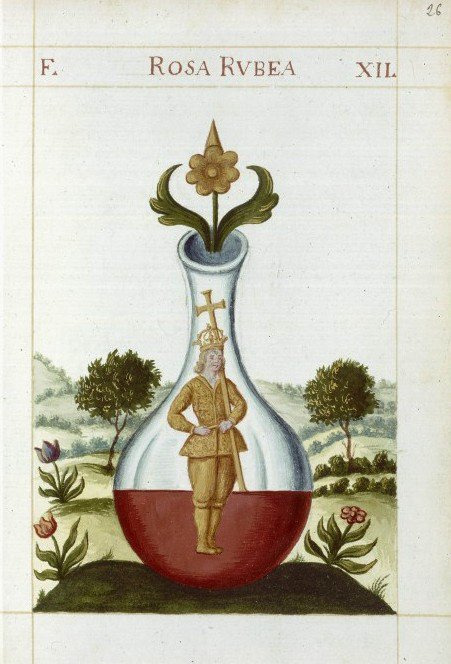
From Pretiosissimum Donum Dei
Labyrinth: The dangerous and confusing process of the Great Work. The labyrinth is full of illusions, and only with divine inspiration can one make one’s way through.
Latona: An imperfect or impure version of the Philosopher’s Stone, represented by bronze or brass (or copper). Similar in nature to the Green Lion. The blackened body of the stone preceding the albedo stage, that must be washed to remove its impurities. She is both metallic ore and the bowels of the earth from which it comes. (The name “Latona” comes from Leto, the mother of Apollo and Artemis, i.e. the mother of gold and silver.)
Laundry: Ablution, washing the Stone to cleanse it of its impurities during the white stage. The stained sheets represent the impure matter, which must be washed so that they will turn pure white. (When the sheets are later dyed red or purple, it represents the rubedo.)
Lead: Prima materia, the raw material that is made into the Philosopher’s Stone and also transmuted by it. The former is “philosophical lead,” the matter of the Stone during the nigredo stage. Represented by Saturn, who can be interpreted as an “aged” Mercurius. White lead is “purified” lead in the albedo stage. Symbolizes the chaotic and melancholic state of the soul after having been separated from itself. (also called Adrop)
Leprosy: The “imperfection” of metals, i.e. lead, copper, tin, and iron are just “diseased” gold and silver. They need “medicine” in the form of the panacea or Philosopher’s Stone. (also called rust)
Lily: The White Tincture and White Stone, the matter of the Stone during the albedo stage. Symbol of purity, perfection, the Moon, and the female principle. Therefore it also represents silver, quicksilver, and Luna/the Queen. It’s paired with a red rose, which represents the male principle. (A white rose symbolizes the same things.)
Lotus: A circular flower with a vertical stalk on horizontal water, therefore the same meaning as the ankh symbol—life, rebirth, resurrection, eternity.
Lute: A kind of clay used to seal the vessel/alembic. It’s made of various things — glue, flower, herbs, honey, egg whites, wax, resin, vitriol…
Magistery/Magisterium: A name for the Great Work. Means literally, “quality of mastery.”
Magnesia: Refers to several substances, all symbols for Terra Alba, “white foliated earth.” Also a name for Mercurius in the form of Quintessence.
Marble: A symbol of the White Stone, which is acquired during the albedo state.
Mars: Represents the metal iron, and the color red. Follows Venus in the Opus, and is associated with the “peacock’s tail” stage. He symbolizes the violent, impure form of the Divine Masculine, symbolized by the Red Lion.
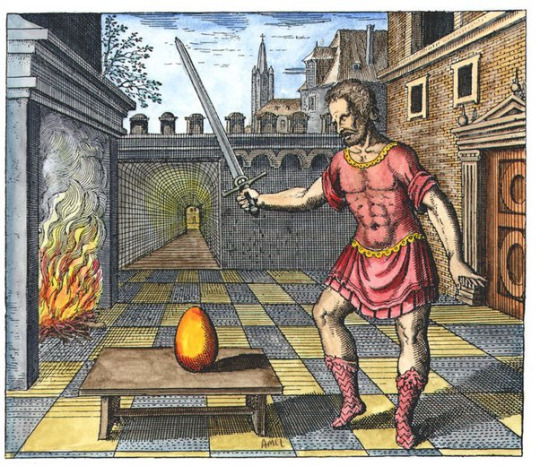
From Atalanta Fugiens
Medicine: The Philosopher’s Stone in the form of a panacea. It can supposedly cure any disease, and also transmute “diseased” metals (copper, iron, tin, lead) into gold and silver. The idea of a panacea is more metaphorical, curing “diseases” of the soul and transforming human beings into enlightened and divine versions of themselves. In short, it raises the vibration of anything it comes in contact with.
Melancholia: The state of mind that accompanies the suffering of the nigredo stage. It is the initial terror and sadness that you experience upon confronting your Shadow. You end up in the “nox profunda,” the deep night or dark night of the soul, a dark pit of the Underworld which it feels like you will never escape.
Menstruum: Mercurial water, the universal solvent. Called the “blood of the green lion.”
Mercurial water: The universal solvent, which dissolves metals and other matter into the prima materia. Symbolized by a lion or a serpent, and also by water (floods, dew, fountains, rain, tears, the ocean). It first “burns” and destroys everything to “kill” the old state of being, but then transforms into the water of life, washes and revitalizes it. (also called alkahest)
Mercurius: The ultimate agent of transmutation, the purified prima materia and the divine spirit within matter. Both the Philosopher’s Stone, and the Opus that produces it. Sometimes Mercury is described as “philosophical water,” or as fire, or as air or vapor (spirit, soul). It is prima materia, the source of metals, and also their potential to turn to gold. It is the primordial “mother” of the Philosopher’s Stone and also the child, the Stone itself. It is self-begotten, self-generative, self-destroying (i.e. the ouroboros). It is the universal solvent of death, and the animating force of life. Hermes is dual-natured and a synthesis of all opposites. He is both light and dark (i.e. celestial and chthonic) and is not tainted or corrupted by his engagement with darkness. He dissolves and coagulates, creates and destroys, kills and revives. He is an elusive trickster, but also a helpful ally. Alchemical Mercury is also a hermaphrodite, both male and female. Mercury is the spirit that unites body and soul, and weds the Red King and White Queen. Since Hermes is the messenger god who transfers information between the human and the divine, and brings the soul between life and death, he is also a mediator between the mundane self and the Higher Self. Mercurius is also a summary of the entire alchemical process. “Binding Hermes” means making his volatile nature, fixed. First he is the dragon or serpent, then the green lion, then the white eagle. Finally, Hermes’ association with commerce relates to the alchemical production of gold. (Also called Azoth, aqua divina, aqua permanens, aqua regia, aqua ardens, aqua vitae) (Note: Mercurius represents the Stone, not actual mercury. For actual mercury, see quicksilver.)
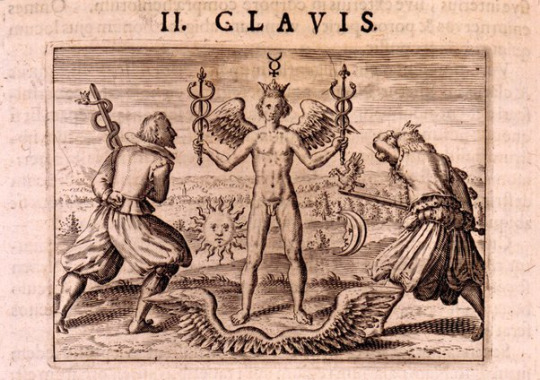
From the Twelve Keys of Basil Valentine
Metamorphosis: A word for transmutation, changing states of matter or states of being. Also, Ovid’s Metamorphoses were referred to as analogies for the Opus by alchemists.
Milk: The pure and spiritual version of mercurial water, extracted from the green lion ore. The White Tincture, which can transmute metal into silver. It nourishes the baby Philosopher’s Stone during the cibation stage.
Mirror: “Divine Spirit,” observing the self, becoming the most divine version of oneself through self-observation and Shadow work.
Moon: Silver and quicksilver/argent vive (actual mercury), the female principle. Also the White Tincture and White Stone in the albedo stage. Luna is married to Sol, the King. Her properties are cold, moist, and receptive to his hot, dry, and active. She is the Divine Feminine, and represents, the imagination, dreams, emotions, intuition, the subconscious, the changeable and volatile, the energetic, the soul. The subconscious is “cleansed” during the white stage. Cold moonlight represents the half-enlightened conscience of the albedo stage. Associated with solve, dissolution, making the mundane spiritual.
Mountains: A symbol for the source of prima materia. To obtain it, the alchemist must climb a mountain and extract the juice of a magic herb that grows on it. Sometimes there’s two mountains, one for the masculine “seed” and one for the feminine one. Going into the mountains can also be a metaphor for isolating oneself to gain spiritual awareness.
Multiplication: Stage Nine. Another sacred marriage/copulation between the Red King and the White Queen, so the Stone can become “fertile.” The Opus repeats itself again and again in rapid succession, with the Stone constantly dissolving and coagulating to create more of itself.
Nest: The Vessel, as a container for the “egg” or “chick” of the Bird of Hermes.
Night: The nigredo, the first stage of the Opus. It’s the Dark Night of the Soul in which the body dies and putrefies, and then is dissolved. The soul experiences a descent into the Underworld.
Oak: The philosophical tree. Also the vessel or athanor, when hollow.
Orphan: The Philosopher’s Stone, because its “parents” (the King and Queen. Sol and Luna) must die so it can be born. The alchemist becomes its foster parent and raises it in their place.
“Our” [substance]: Alchemists use the word “our” to refer to spiritual/metaphysical symbols represented by substances. So, “our mercury” isn’t Hg, it’s the feminine principle of nature. “Our sulfur” is the masculine principle of nature. “Our gold” is the perfect state of being, and not actual gold, Au. “Our [symbol]” refers to the metaphorical thing the symbol represents, not the symbol itself. It was never about making actual gold. If you think it is, you’re missing the point.
Ouroboros: The universe and the Great Work. The Ouroboros is and encircles all things, and thus represents the Principal of Mentalism. It is the circle of life — life returns to that which generated it, and supports other life. It creates itself, and also destroys itself (since it bites its own tail), and therefore is also primordial chaos and prima materia. All things come from it and return to it, and it continues in an eternal cycle. It represents the cyclical nature of the Opus, and also the eternal process of solve et coagula – killing itself, resurrecting itself.
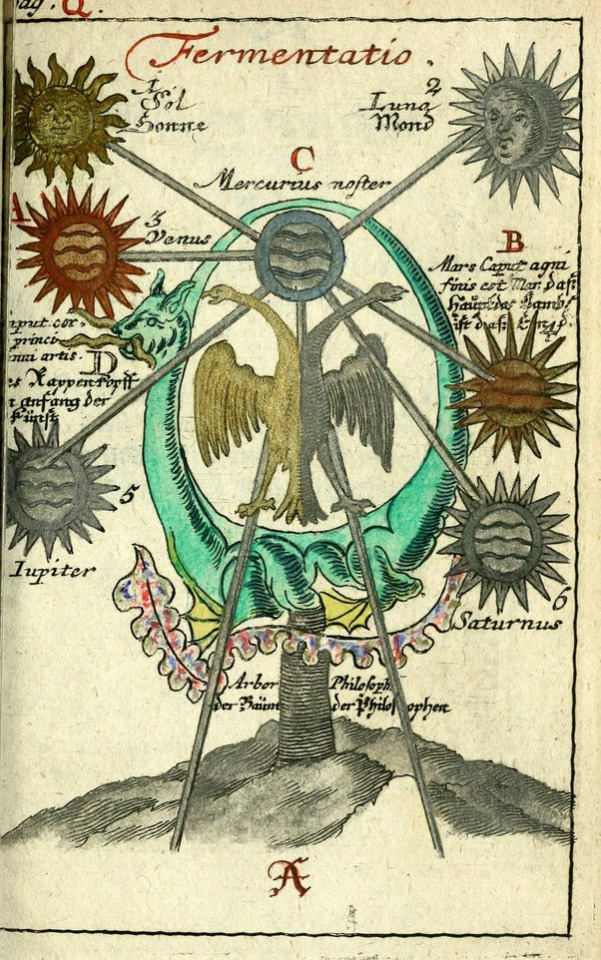
From Compendium Alchemyst
Paste: The whitened matter of the Stone. During the fermentation stage, another chemical wedding happens between the Stone’s purified soul and this white purified body, which is compared to making bread. The paste is bread dough.
Peace: The state when the opposing forces of the Opus (male and female, sulfur and mercury, fixed and volatile, body and soul, etc.) stop fighting with each other and are united in the chemical wedding. This is why a dove officiates the wedding. Signified by the “peacock’s tail” stage.
Peacock’s Tail: The stage between nigredo and albedo, when the stone is washed with mercurial water during ablution. As the blackness is washed away, it is replaced by the iridescent colors of the rainbow. Instead of white splitting into many colors as in a prism, the many colors coagulate into white. Eating the peacock’s flesh integrates the rainbow colors into the single white color, a state of purity and wholeness.

From the Ulrich Ruosch Manuscript
Pearl: A symbol of the ablution stage, because the drops of condensation that result from distillation look like pearls. Also a symbol of the White Stone.
Pelican: A symbol of the cibation and multiplication stage. The pelican bites her own chest to feed her hatchlings with her blood, like the Bird of Hermes feeding the baby Stone with the Red Tincture. (Pelicans don’t actually do this, but were believed to, and were considered symbols of Christ for their sacrifice of their own blood for their young.) Also a particular type of vessel.

From the Ulrich Ruosch Manuscript
Philosopher: An alchemist. This alone is an indication that alchemy isn’t about science, but about attaining spiritual wisdom. Hence why alchemical substances or symbols are described as “philosophical” – it’s not the literal, physical thing that matters, but the metaphorical or spiritual thing. Alchemy really happens in the mind, not in the laboratory. The alchemists sought to discover how the world works on both a physical level and a spiritual level, simultaneously.
Philosopher’s Stone: The ultimate goal of alchemy, substance that can supposedly perfect all imperfections (which I interpret to mean, it raises the vibration of anything it comes in contact with). It is the substance of divine love and creative power, a crystallization of the essence of life. It can supposedly turn lead into gold, heal all illnesses, and do various other miraculous things. It is created by reproducing God’s creation of the world in the microcosm of the alembic. It is supposed to be a perfect balance of all four elements, and is born from the divine union of the archetypal male and female forces of the universe. It is supposedly created by reproducing God’s creation of the world in the microcosm of the vessel, beginning with primordial first matter (prima materia) and shaping it into sulfur and mercury, which then “marry” and combine to produce the Stone. Honestly, seeking the Philosopher’s Stone is like going on a long Epic Quest for some magical unattainable object (like the Holy Grail or El Dorado), only to discover that It Was Inside Of You All Along, but the journey itself facilitated your character development to make you a better version of yourself. The point was always the journey; the Philosopher’s Stone is a natural result of having undertaken the Opus at all.
Philosophical Child: The newborn Philosopher’s Stone, the result of the Chemical Wedding. The final part of the Opus is compared to raising a child, who is fed and nourished by the alchemist. He grows up into a king and a magician who has power to “vanquish every subtle thing and penetrate every solid thing,” cure all disease, transmute all metals.
Philosophical Mercury: Prima materia or Mercurius. Not the same as “vulgar mercury” or quicksilver (Hg).
Philosophical Tree: Represents the Philosopher’s Stone, the process of the Opus, and also the “expansion of consciousness” that results from it. The process of making the Stone is compared to the cultivation of a tree, and the Stone multiplies itself like a tree bearing fruit. The tree grows from a seed, the “seed” of metals within prima materia, is nourished by rain, and it finally bears gold and silver fruit that represent the Sun and Moon (as well as “perfect” metal). This is all a metaphor for the spiritual growth of the soul towards its ultimate divine form. Sometimes the tree is instead a flower (like the red roses and white lilies, representing the Red and White Tinctures), or a magic herb. Sometimes there are two trees, a gold solar tree and a silver lunar tree. Sometimes it has seven branches to represent the seven planets, making it a symbol for prima materia. Sometimes it grows on an island in a sea of mercurial water, sometimes it grows on a mountain of prima materia, and sometimes it grows in a magical garden of wisdom.
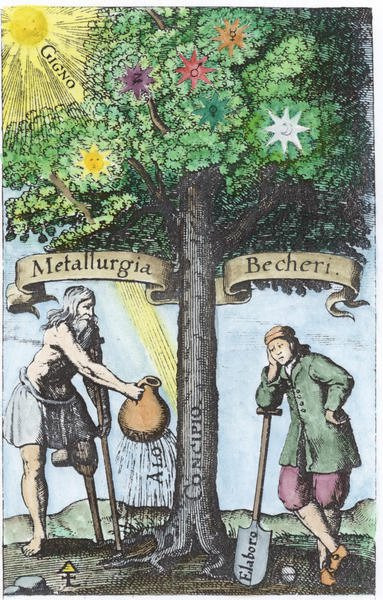
By Johann Joachim Becher
Phoenix: Resurrection, the Philosopher’s Stone in the red stage. Fire in its purest and most spiritual form. Represents rubedo and the multiplication stage, when the Stone/elixir replicates itself. It has been resurrected, and has the power to resurrect itself and others indefinitely.
Poppy: The rubedo, the red color of the Stone or Red Tincture in the final stage.
Pot: The vessel, in this case described as being made of clay and filled with dung to act as a container for the first Chemical Wedding and the nigredo, becoming “pregnant” with the seed of the Stone.
Prima materia: “First matter,” the primordial essence of all things. Alchemists believed that everything was made out of an original substance from which the world was made, and that if you could distill and refine matter (metal, for instance) all the way down into this original substance, you could reshape into whatever you wanted. i.e., reduce lead down to prima materia and then reform it as gold by putting a “seed” of gold into it. Hence “solve et coagula,” dissolve and reform. Symbolically, prima materia represents the soul in its original state. You have to be able to break down the person you think you are, until you are left with nothing but the true core of your being. In Jungian symbolism, it is also the subconscious mind, a dark and scary place that is also the source of inspiration and growth. Prima materia is compared to dirt or dung by alchemists, because it is supposed to something normal and mundane that is found everywhere, and dismissed as worthless by the uninitiated. There are so many symbols related to it, especially water, snakes, earth, seeds, blood, Saturn, chaos, and lead.
Prison: The vessel during the putrefaction stage. The alchemical lovers, Sol and Luna, are imprisoned in it and left to die while their souls rise to the top of the vessel.
Projection: Stage Ten. Using the Stone to transmute other metals, completing the cycle. The Stone raises the vibrations of everything it comes into contact with.
Proteus: The shapeshifting sea god in Greek mythology, a symbol of Mercurius in its volatile state, which takes on many confusing forms and has to be held down until it is tamed and takes its original shape. The sea that Proteus lives in is pirma materia.
Purple: Sometimes used to describe the Philosopher’s Stone and Tincture in its final rubedo state, instead of red. This is because Tyrian purple is very rare and hard to get, must be extracted from snails, and is only worn by royalty. It is the color of attainment, spirituality, and mastery.
Putrefaction: Stage Four. Subjecting the material to a moist heat and letting it turn black. It is now a dead thing with all of its characteristics stripped from it, prima materia. Vapor (the life-spark) leaves it. Represents spiritual death, melancholy, dejection, suffering. The Dark Night of the Soul. Death of the old self paves the way for a new mode of thinking, initiation.
Queen: The matter of the Stone during the albedo. The cold and moist female principle — mercury (Hg) in its impure state, silver in its pure state. She is the Moon, and must be “married” to her male counterpart, who represents sulfur and the Sun. She is also mercurial water in its role as the replenishing water of life or nourishing milk, the White Tincture. She represents the subconscious, perception and the imagination, “higher” spiritual and moral faculties, and the Divine Feminine.
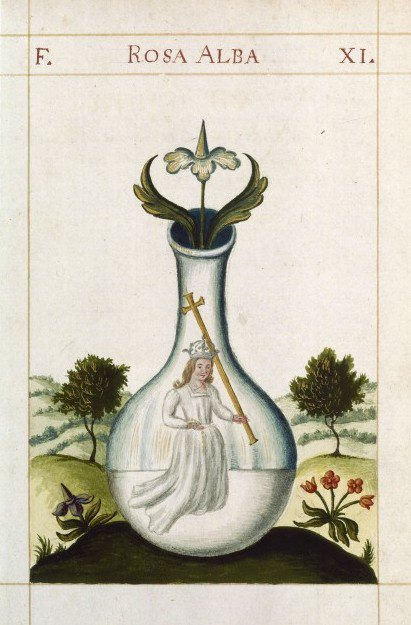
From Pretiosissimum Donum Dei
Quicksilver: Mercury (Hg). The agent of the feminine principle, the “unripe” form of silver. Cold, moist, receptive feminine “seed” of metal that unites with Sulphur to form the Philosopher’s Stone. It is made of Earth and Water. Confusingly, it can also be a symbol for Mercurius in its “slippery” and elusive form. In Paracelsian alchemy, it represents the spirit, the animating force of life. Sometimes also a synonym for prima materia, represented by the dragon or serpent. It has the power to dissolve or vaporize fixed matter. (Also called argent vive.)
Quintessence: (also called Azoth), the fifth element and the result of unifying the other four. It is what the Stone is made of, and in liquid form it is the Elixir of Life. It is purified prima materia, an inherently spiritual substance. Believed to be a panacea. (I interpret it as being able to raise the vibration of anything it comes in contact with.) Symbolized by a crowned maiden, or by Mercurius.
Rainbow: The peacock’s tail stage, which occurs during ablution, when mercurial water falls like rain onto the black dregs. The many colors of the rainbow integrate into white, representing the calmness and receptiveness of the soul.
Raven: Nigredo, when the impure matter of the Stone dissolves and putrefies in the bottom of the flask. It is the initial, death stage of the Opus.

From the Ulrich Ruosch Manuscript
Red: The rubedo, the final stage of alchemy in which the white matter of the Stone turns crimson as the spirit merges with the body. It crystallizes and becomes fixed. Self-actualization and resurrection, the attainment of spiritual enlightenment. Symbolized by blood, red roses, rubies, coral, gold, the Sun, the phoenix, and the King.
Red earth: A name for the base matter of the Philosopher’s Stone, which is dissolved into prima materia and then refined into the Red Stone and Red Elixir.
Red Elixir: The Philosopher’s Stone in liquid form, as a panacea. It can cure all diseases, transmute metals into gold and silver, raise the dead, make old people young again, give strength to living beings, etc. It is “fed” to the baby Stone during the cibation stage, so that the Stone will be multiplied by itself and produce more of itself. (Also called the Red Tincture)
Red Lion (or Dragon): Represents sulfur and the planet Mars. It’s Sol, the masculine principle, in its “impure” state at the start of the Opus: the wild, animalistic, instinctive part of the soul that needs to be “purified” by being defeated. It is “terrestrial man,” the King at his most mundane. It burns everything that it comes into contact with.

From Clavis Artis
Red powder: The Stone in powdered form. It’s cast over or mixed with metal to transmute it, and taken as a medicine.
Red Sea: Another symbol for prima materia and mercurial water, the source of life and death that both dissolves everything and revitalizes it. The crossing of the Red Sea in Exodus is a symbol for how its waters will destroy the uninitiated and show the way forward to the enlightened. It also can be “parted” into four elements.
Refine: Purifying a substance by repeatedly dissolving and coagulating it with water and fire, which slowly removes its defects. This is a metaphor for raising the “vibration” of the soul, from a lower, mundane state to a higher, spiritual state. The soul must endure many trials (fire and water) to reach this state of spiritual purity, until it is pure enough to permanently fuse with the spirit of God and become divine-in-human. Becoming “gold” is to be able to withstand the heat of any “fire” (gold has a very high melting point) and host the Sun within oneself.
Return: The “process of return” is a name for the Great Work, because it is a cyclical process of repeated “solve et coagula.” The matter of the Stone must return to prima materia, the four elements to quintessence, the soul to the perfected state that it was in at the creation of the world, the world itself from the dismal “Iron Age” to the ideal “Golden Age” of the distant past.
River: Another symbol of mercurial water. There are two rivers, one male and one female. The female one dissolves, and the male one coagulates. When the two rivers flow together into a single river, it represents the Chemical Wedding. When the rivers dry up, it represents the crystallization of the Stone in the dry, solar rubedo stage.
Rock: A synonym for the Philosopher’s Stone, for the mountain of prima materia, and also for the vessel in which the Stone is made.
Roots: The four elements are the “roots” of the philosophical tree, from which the Philosopher’s Stone grows.
Rose: The rubedo and the Philosopher’s Stone, the completion of the Opus. A blooming rose represents attaining wisdom and enlightenment. If a red rose is paired with a white lily (or a white rose), it represents the Red Tincture and the King/Sol.
Ruby: The Red Stone. The “celestial” ruby has the power to transmute all metals and make anyone enlightened.
Sable robe: Black garments (mourning clothes) are another symbol of the nigredo, the dark night of the soul.
Sal ammoniac: Ammonium chloride. It’s a symbol of the White Tincture, the matter of the Stone during sublimation, after it has been dissolved. It’s represented by the eagle. It’s also an ingredient in aqua regia, because it produces hydrochloric acid when dissolved.
Salamander: Sulfur, the hot and dry male principle and the masculine “seed” of metals. Although salamanders are amphibious creatures, they were believed to be able to withstand flames, hence why they’re associated with fire. Paracelsus named them as fire elementals, implying that (in this context) salamanders are a type of spirit. Also represents the Philosopher’s Stone and Red Tincture, similarly to the phoenix. The salamander’s blood is the panacea.

From Atalanta Fugiens
Salt: Represents the body and the state of fixation in Paracelsian alchemy, with mercury being the spirit and sulfur the mediating soul. Traditionally, though, it’s a synonym for ashes and white foliated earth, another symbol of matter of the Stone in the white stage.
Sand: Another version of the bath, but the Vessel is placed in heated sand instead of water. Red sand is also a symbol of the raw matter of the Stone.
Sapientia: Divine knowledge and wisdom, which is what the alchemist ultimately hopes to obtain. It is the divine feminine principle, represented by the Queen. Wisdom is personified as a beautiful woman who is an emanation of God. She is the active ingredient in the panacea.
Saturn: Represents the metal lead, and the color black. Also a name for prima materia and for the matter of the stone during the putrefaction stage. In general, Saturn represents discipline, death, and melancholy, so her rules over the harsh nigredo stage. Sometimes he is portrayed as a Grim Reaper or Father Time figure, who destroys all old things to make way for new things.
Sea: Mercurial water, prima materia, the source of all creation. Most creation stories begin with primordial waters of some kind, so of course, the ocean represents this primeval soup of prima materia that contains the potential for all things. (Modern science tells us that life on earth literally did begin in the ocean.) Drowning the King in the sea represents dissolution.
Seed: The spark of life. All metals were thought to have a “seed” within them that could produce the Philosopher’s Stone, when the metal was dissolved into prima materia and the seed extracted from it. The hot and dry male seed is sulfur, and the cold and moist female seed is quicksilver. The seed could theoretically “grow” into gold, under the right conditions and with aid from the Philosopher’s Stone.
Separation: Stage Three. The mixture of ash and “water” separates into its base materials (the four elements, mercury and sulfur, etc.). This represents sorting out the aspects of your mind. It feels like you’re now split in two, Ego and Shadow, warring with yourself. There’s a danger of self-loathing.
Serpent: Prima materia. Mercurius in the form of primordial chaos, dark and destructive. The universal solvent is the serpent’s venom, which can reduce any metal to prima materia. Chthonic or cosmic serpents so often represent primordial creation in mythology — Apophis and Nehebkau in Egypt, Tiamat in Mesopotamia, Shesha in Hinduism, etc. Mercurius also manifests as two serpents that represent the male and female seeds of metals – the female one is winged, and therefore the volatile spirit hidden in the matter of the Stone, while the male one is fixed and does not have wings. They fight each other until Hermes places his wand between them, and they coil around it to form the caduceus. After these two serpents die in the nigredo stage, the primordial serpent becomes the river serpent who cleanses and resurrects them with the water of life. Finally, it becomes the representation of the Philosopher’s Stone.

From The Crowning of Nature
Ship: The vessel, during nigredo and the dissolution that follows. If dissolution is symbolized by a flood, then the alchemical vessel is the ship. Same symbolism as a coffin.
Silver: The symbol of the albedo stage, the Whtie Stone, and the White Elixir, as well as the Moon and the Queen. A pure, condensed form of the lunar force and the Divine Feminine.
Snow: The matter of the Stone during the albedo, the same as white foliated earth. The dust that collects on the side of the vessel during sublimation. Throwing snow in Saturn’s face is a symbol of turning the blackened matter of the stone white, as the Work progresses into the albedo stage.
Seven: Creative power, transcendence. Three creative principles (sulfur, mercury, salt) + four elements, nature creating nature. Transitioning to “nonhuman” consciousness.
Soul: The vapor that results from dissolution, because it is volatile and therefore the spiritual part of a living being. The divine or “higher self.” When the matter of the Stone is dissolved into prima materia, the soul is released and floats upward. It unites with the spirit in the Chemical Wedding, during the albedo stage.
Spirit: The spark of life, the spiritual essence of a person or substance, mediating between the dead body and the soul. Symbolized by flying birds in the flask, and represented by mercury (quicksilver) in Paracelsan alchemy
Square and Circle: A symbol of the Philosopher’s Stone. The square represents the four elements, and “squaring the circle” means uniting those four elements into one Quintessence. The four-sided square is the material world, and the eternal circle is the spiritual world. It’s also a symbol of sacred geometry and harmony, the proportionality of the microcosm to the macrocosm.

From Philosophia Reformata by Johann Daniel Mylius
Stain: The impurities in the matter of the Stone that have to be filtered out through the continued process of refinement, solve et coagula. Ablution is the stage of washing the stains away, following death and dissolution. Washing away the stains is a metaphor for acknowledging one’s own shortcomings, and working through one’s faults to become a better person,
Star: Another symbol of Mercurius. A six-pointed star represents Mercurius’ ability to unite opposites (the upward- and downward-facing triangles; as above, so below), If it has a sun and moon in the middle, it represents the Chemical Wedding. A six-pointed star also contains the triangular symbols for all four elements. Stars also symbolize the Stone as the perfected human being. The “milk” that the baby Stone is nourished with comes from the stars. (Also a symbol of antimony, because antimony crystallizes in a star pattern when reduced with iron.)
Sulfur: An “impure” (physical) agent of the masculine principle, the “unripe” form of gold, Hot, dry, active masculine “seed” of metals that has to combine with feminine mercury (quicksilver) to form the Philosopher’s Stone. It is made of Air and Fire. It is not literal sulfur, but the mundane mind or consciousness. It is combustive and violent, but it is able to fix the volatile. It is symbolized by a red lion or the Devil. In Paracelsian alchemy, it represents the soul, and is the force of structure, stability, substance, and growth.
Sun: Represents the metal and color gold, and “philosophical gold.” He is the Divine Masculine, represented by gold, or sulfur (in an impure state). Sol is married to Luna, the Queen. His properties are hot, dry, and active to her cold, moist, and receptive. He represents individualization, completion and perfection to the point of centrality, stability, equilibrium, and order. The state of being divine. Also represents the illumination of consciousness, the Red Tincture, and Red Stone during the rubedo, at the completion of the Opus. It represents the state of being the Philosopher’s Stone, the “perfect incarnation.” Its rays have the power to transmute metal and give life. Associated with coagula, congelation, the giving of form and physicality to the subtle or spiritual.
Sun and Shadow: A strange symbol of the projection, the final stage of the Opus. The Sun shines, and casts a shadow, which is a symbol of the Philosopher’s Stone being cast over other metals to turn them to gold. The Shadow is part of what makes the Sun what it is, because wherever there is light, there is shadow. Sometimes the Shadow itself is the Philospher’s Stone, because it is a microcosm of the Sun, which is the macrocosm. It is like a reflection or impression of the Sun. Sometimes the Moon is the Shadow, because it reflects the Sun’s light, so the lunar eclipse is the Chemical Wedding – the integration of conscious and subconscious. During the lunar eclipse, the moon turns red, like the Philosopher’s Stone. The solar eclipse symbolizes the beginning of the Great Work, while the lunar eclipse symbolizes the end, though both could be interpreted as symbols of the Dark Night of the Soul and the integration of the Shadow self.
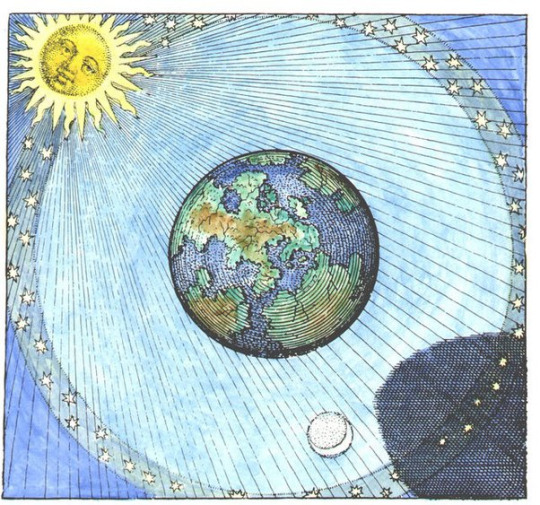
From Atalanta Fugiens
Swan: The albedo, the White Tincture and the White Stone. It swims in the mercurial water, It is feminine and lunar, and able to transmute metals into silver, and represents spiritual purity.
Sweat: The dew or condensation on the side of the vessel during the distillation phase, and is used to wash the dead body of the King during ablution. It’s also the King’s own sweat as he dies, therefore Mercurius as the waters of both life and death.
Sword: Represents “philosophical fire,” the destructive force of Mars and the Red Lion/Dragon. It kills the King (the matter of the Stone), which results in the nigredo stage. (An axe, a knife, Saturn’s scythe, or animal teeth and claws all have the same symbolism)
Tartarus: The dregs or sediment of wine. The Underworld, that which is left behind by the once-living world.
Tears: Mercurial water in the form of the water of life that washes the dead matter of the Stone and cleanses it of impurities. Same symbolism as sweat and dew/rain, the condensation on the sides of the alembic during distillation. In this context, the tears come from grief over the dead King, bird, or lovers.
Temple: Another name for the Vessel, containing all the secrets of alchemy and generation.
Theatre: Alchemical treatises call themselves “theatres,” because they provide a view of the Opus. The Opus itself is compared to a theatrical performance taking place on a stage, and watched by an audience, with all the apparatus being the set and the individual stages being acts and scenes. The theatre is therefore another symbol of the Vessel or alembic.
Tincture: A liquid that is able to tint or color other things. The Stone in liquid form is called a “tincture” because it is able to “color” metals when poured on them to turn them into gold and silver.
Toad: The matter of the Stone during the putrefaction stage, which is black, ugly, and swollen. Also a symbol of prima materia – hardened, earthy primordial matter that’s poisonous but that can be made into the Stone. Means the same thing as the snake or dragon, the crow or raven, and the Green Lion. If paired with a volatile eagle, it represents sublimation.
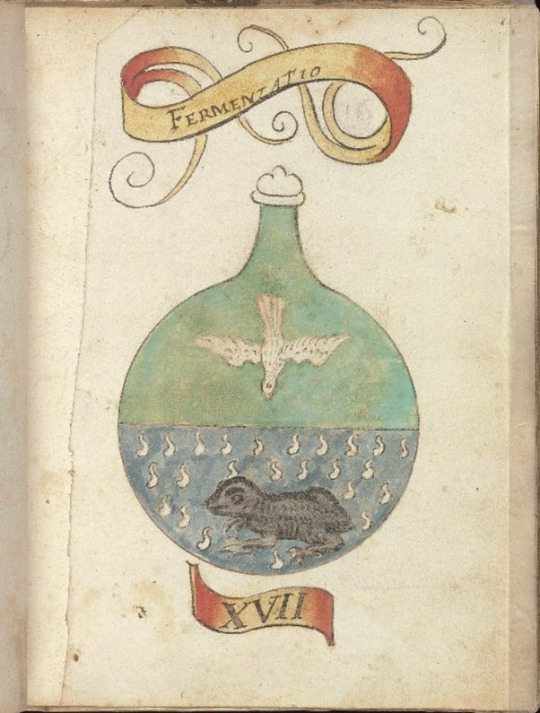
From The Crowning of Nature
Torture: Calcination, reducing a metal to ashes and prima materia during the nigredo stage. This requires being burned in purifying fire. Beheading the king, chopping down a tree, or the bird eating its wings all represent the same thing. This is a symbol of the psychological torment that one must go through during the nigredo, to become self-aware and spiritually pure.
Trees: Prima materia — the force of manifestation, wisdom, the Divine, alternately a creative and destructive force. Yggdrasil provides wisdom to Odin at the cost of his suffering. The Tree of Paradise provides divine knowledge at the cost of sin, etc. Also, “As above, so below,” since the tree’s roots spread beneath it and the branches spread above it. It can also represent the dual nature of mankind, being both divine and mortal, connected to the Astral world and the terrestrial world.
Twins: Sometimes the Red King (sulfur) and White Queen (quicksilver) are interpreted as twins, the two principal forces of nature that are born from prima materia and united with each other. They seem to be opposites, but they’re of the same stock. Sometimes they’re conjoined into a two-headed hermaphrodite.
Unicorn: The masculine aspect of Mercurius, which can penetrate with its horn. Represents the spirit, while the deer represents the soul. The deer and unicorn must both be captured and tamed by the alchemist, so that they will mate with each other, representing the second Chemical Wedding between soul and spirit (during the albedo stage). The unicorn can only be tamed by the Virgin, who represents the feminine aspect of Mercurius.
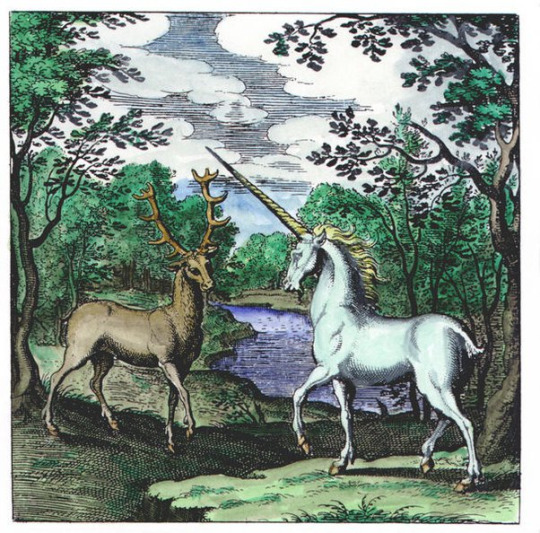
From The Lambspring
Urine: Mercurial water during the putrefaction stage, the universal solvent.
Venom: Alkahest — mercurial water at the beginning of the Opus, as a universal solvent that burns and destroys everything it comes into contact with. It “kills” the matter of the Stone during the nigredo stage, reducing it to prima materia. It is symbolized by venomous animals (or animals thought to be venomous) like snakes and toads. Also symbolized by the blood of the dragon or Green Lion. The venom is then transmuted into the water of life. Spiritually, this is a symbol of the psychological turmoil that you go through when you first become aware of your Shadow or lower self, which becomes a blessing once you overcome it. Self-awareness is painful at first, but is a means towards divine knowledge and purity. (also called vinegar)
Venus: Represents the metal copper, and the color green. She is the impure version of the Divine Feminine, just as Mars is the impure version of the Divine Masculine. She first appears as a “whore,” representing the impure matter of the Stone that quicksilver (a purer version of the Divine Feminine) must be extracted from. Mars and Venus are the alchemical couple before they become Sol and Luna. Sometimes she also presides over the Chemical Wedding and its results, wearing green. The matter of the Stone turns green just after the black nigredo and just before the rainbow Peacock’s Tail.
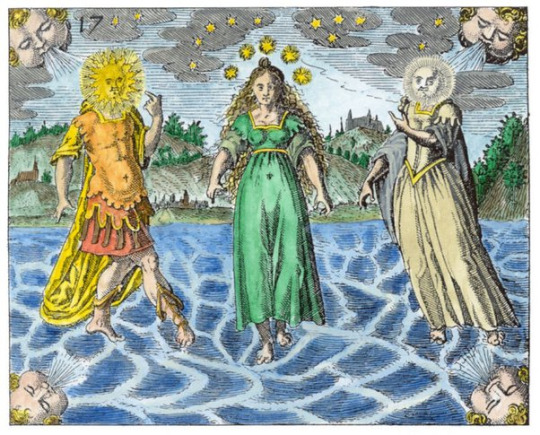
From Philosophia Reformata by Johann Daniel Mylius
Vessel: The flask or alembic in which the Philosopher’s Stone is made. Spiritually, it represents you – your body and consciousness. Your microcosm, in which the Great Work takes place.
Viper: The impure matter of the Stone at the beginning of the Opus, and also the mercurial spirit that is released from it when it is dissolved. It is poisonous and violent, because it has not been refined yet.
Virgin: The feminine aspect of Mercurius. Prima materia, which was “impregnated” by God to create the world, and generates all things. Also a symbol of argent vive (quicksilver), the cold and moist feminine principle. Represented by Diana (Artemis), the virgin huntress, who is also a symbol of the Moon (i.e. the Queen). Sapientia (wisdom) is also a form of the Virgin, this time representing the Philosopher’s Stone. In this aspect, she is a cosmic world-soul (similar to Hecate in the Chaldean Oracles). “Virgin’s milk” is the purifying and transforming form of mercurial water, and the White Tincture.
Vitriol: Sulfate, or sulfuric acid. “Green vitriol” (iron sulfate) is the impure matter of the Stone (i.e. the Green Lion), while “red vitriol” is purified sulfur.
Vulcan: Hephaestus, the smith of the gods, who is the archetypal alchemist in Paracelsian alchemy. This is probably because he works with metal and makes things out of gold. He also represents the “secret fire,” the purifying divine fire.
Vulture: The Bird of Hermes and a symbol for the entire alchemical process, because it is black, white, and red.
Water: The element, the essence of peace. Prima materia, primordial creation, chaos, darkness/the Abyss, philosophical mercury. It is cold and moist, and contains infinite possibility and creative potential, as well as volatile destruction. Also represents the Divine Feminine (i.e. the womb of creation). Symbolized by the Moon and quicksilver (mercury). In its destructive form, mercurial water is the universal solvent that reduces everything to prima materia, and then it transmutes into the purifying and revitalizing water of life.
Watering [plants]: Watering the philosophical tree symbolizes distillation and ablution, imbuing the body of the Stone with its spiritual essence.
Well: The vessel during dissolution, the container for the mercurial water. Another symbol for the baptismal bath or fountain.
White: The albedo, the second stage of alchemy, when the vapor from the dying matter of the Stone rises to the top of the alembic, and the dead body of the Stone is washed in the mercurial waters. The human soul is washed clean of its sins and sorrows at this stage, and is capable of receiving divine love and inspiration. It represents purity and the giving of new life. Symbolized by milk, white roses, lilies, silver, snow, the water of life, the Moon, the swan, the dove, and the Queen.
White Elixir: The White Stone in liquid form, an elixir with the power to transmute base metal into silver, obtained at the albedo stage. It can cleanse anything of its stains and purify matter into a near-perfect state. It is the milk that is “fed” to the baby Philosopher’s Stone during cibation. (Also called the White Tincture).
White Foliated Earth: The matter of the Stone in the albedo stage, which has decomposed, been purified, and become white fertile soil. The seed of gold is “planted” in it, so that the Stone will be able to transmute base metal into gold. The white earth is watered when the soul reunites with the body. Symbolized by ash, dust, salt, or snow, and Luna/the Queen.
White Stone: The matter of the Stone as it is during the albedo stage, able to transmute base metal into silver. It is the mundane body having become pure and spiritual through repeated refinement (distillation/sublimation). Symbolized by Luna, the White Queen.
Wind: The vapor at the top of the flask, Mercurius during the sublimation stage. It is the soul that contains the life-spark, “the wind shall carry it in its belly.” The Stone at its most subtle. Eventually, it condenses and turns to water, then falls back to Earth again. (Also called zephyr)
Wolf: Antimony. It devours the body of the King when he dies during the nigredo stage, symbolizing his destruction by the mercurial waters. Similar symbol to the Green Lion.
Womb: The vessel, in which the Stone is conceived. Also a symbol for the bath or fountain that cleanses the matter of the Stone, and a symbol for the white foliated earth in which the “seed” of metals grows. The earth is “impregnated” by the spiritualized soul, which condenses and falls to the earth. When this happens, the Stone is born.
Worm: Another symbol for the mercurial water and secret fire, that destroys and then revitalizes matter. Interchangeable with the serpent or dragon. It decomposes the dead body of the Stone during the putrefaction, eating away all corruption.
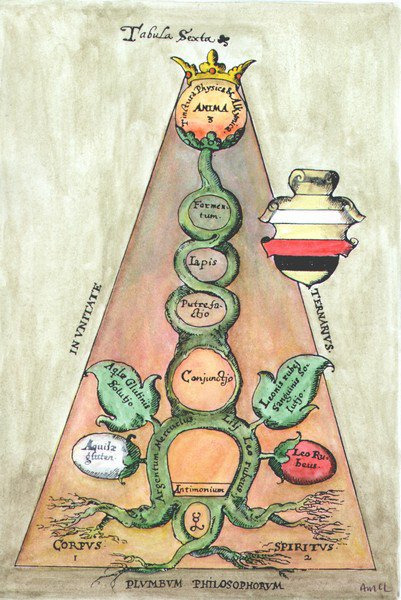
From The Marrow of Alchemy by George Ripley
#alchemy#alchemical symbols#alchemical symbolism#hermeticism#hermetic symbolism#alchemical#mercurius#occult#occultism#occult symbolism#dictionary#symbolism#symbol dictionary#philosopher's stone#long post
158 notes
·
View notes
Text
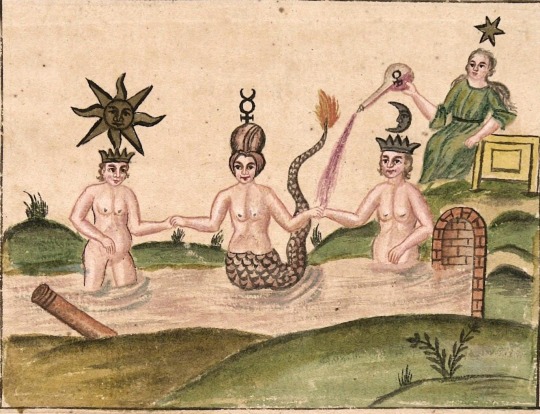
1 note
·
View note
Text
"Unlocking the Esoteric Tapestry: A Journey Through 'The Alchemical Writings of Edward Kelly'"

"The Alchemical Writings of Edward Kelly" invites readers into the mystical realm of alchemy through the eyes and pen of the enigmatic Edward Kelly, a figure deeply intertwined with the alchemical pursuits of the Renaissance. This collection, skillfully compiled and annotated, unveils the arcane wisdom and esoteric insights of a man whose contributions to the Hermetic arts have long been shrouded in mystery.
Kelly's writings, presented with meticulous attention to historical context, offer a profound glimpse into the spiritual and transformative aspects of alchemy. The editor's annotations guide readers through the labyrinth of alchemical symbolism, providing clarity without diminishing the mystique. From the famed Enochian system to the allegorical language of transmutation, Kelly's words resonate with seekers of hidden truths.
The anthology captures Kelly's alchemical opus, showcasing the intricacies of his experiments, the symbolism embedded in his writings, and the quest for spiritual enlightenment. It serves as a key to decoding the cryptic language of alchemy, making it accessible to both seasoned practitioners and curious minds.

(The illustration presented in the book: a black rock, on which stand, hand in hand, the planets: 1, Black Saturn, falling down; 2, Jupiter; 3, Mars; 4, Mercury of many colours; 5, Venus, with green robe, and the Sun and Moon. Lower down, on the black rock, stands an old man with a pick-axe, cutting a piece out of the rock, whence Saturn falls, and near him lie, as if dead, Jupiter and Saturn.)
As the pages unfold, readers are immersed in the alchemical laboratory of Kelly's mind. The author's profound understanding of the mystical journey, coupled with his ability to articulate complex concepts, makes this collection a valuable resource for those exploring the intersections of spirituality, philosophy, and the arcane sciences.
In conclusion, "The Alchemical Writings of Edward Kelly" is a captivating odyssey into the depths of alchemical thought. Whether you are a seasoned alchemist or a curious soul embarking on the quest for inner transformation, this anthology is a beacon of enlightenment. Prepare to be entranced by Kelly's alchemical tapestry—a rich weave of symbols, insights, and secrets that beckon the daring to unlock the mysteries of the alchemical tradition.
"The Alchemical Writings of Edward Kelly" is available in Amazon in paperback 12.99$ and hardcover 18.99$ editions.
Number of pages: 143
Language: English
Rating: 10/10
Link of the book!
Review By: King's Cat
#Edward Kelly#Alchemical writings#Hermetic wisdom#Enochian system#Renaissance alchemy#Mystical transformation#Esoteric symbolism#Spiritual enlightenment#Alchemical experiments#Transmutation allegories#Hidden truths#Cryptic language#Alchemical opus#Inner transformation#Arcane sciences#Alchemical philosophy#Spiritual journey#Elixir of life#Occult symbolism#Mystic insights
1 note
·
View note
Text
"Unlocking the Esoteric Tapestry: A Journey Through 'The Alchemical Writings of Edward Kelly'"
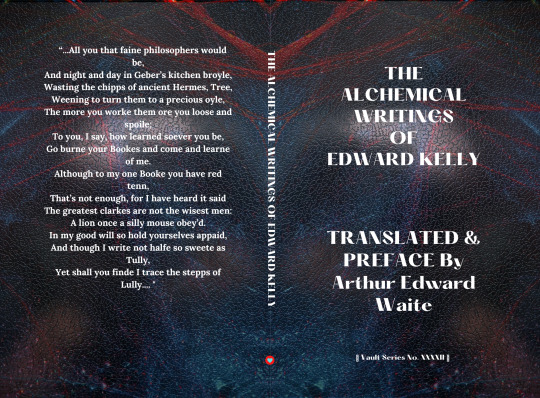
"The Alchemical Writings of Edward Kelly" invites readers into the mystical realm of alchemy through the eyes and pen of the enigmatic Edward Kelly, a figure deeply intertwined with the alchemical pursuits of the Renaissance. This collection, skillfully compiled and annotated, unveils the arcane wisdom and esoteric insights of a man whose contributions to the Hermetic arts have long been shrouded in mystery.
Kelly's writings, presented with meticulous attention to historical context, offer a profound glimpse into the spiritual and transformative aspects of alchemy. The editor's annotations guide readers through the labyrinth of alchemical symbolism, providing clarity without diminishing the mystique. From the famed Enochian system to the allegorical language of transmutation, Kelly's words resonate with seekers of hidden truths.
The anthology captures Kelly's alchemical opus, showcasing the intricacies of his experiments, the symbolism embedded in his writings, and the quest for spiritual enlightenment. It serves as a key to decoding the cryptic language of alchemy, making it accessible to both seasoned practitioners and curious minds.

(The illustration presented in the book: a black rock, on which stand, hand in hand, the planets: 1, Black Saturn, falling down; 2, Jupiter; 3, Mars; 4, Mercury of many colours; 5, Venus, with green robe, and the Sun and Moon. Lower down, on the black rock, stands an old man with a pick-axe, cutting a piece out of the rock, whence Saturn falls, and near him lie, as if dead, Jupiter and Saturn.)
As the pages unfold, readers are immersed in the alchemical laboratory of Kelly's mind. The author's profound understanding of the mystical journey, coupled with his ability to articulate complex concepts, makes this collection a valuable resource for those exploring the intersections of spirituality, philosophy, and the arcane sciences.
In conclusion, "The Alchemical Writings of Edward Kelly" is a captivating odyssey into the depths of alchemical thought. Whether you are a seasoned alchemist or a curious soul embarking on the quest for inner transformation, this anthology is a beacon of enlightenment. Prepare to be entranced by Kelly's alchemical tapestry—a rich weave of symbols, insights, and secrets that beckon the daring to unlock the mysteries of the alchemical tradition.
"The Alchemical Writings of Edward Kelly" is available in Amazon in paperback 12.99$ and hardcover 18.99$ editions.
Number of pages: 143
Language: English
Rating: 10/10
Link of the book!
Review By: King's Cat
#Edward Kelly#Alchemical writings#Hermetic wisdom#Enochian system#Renaissance alchemy#Mystical transformation#Esoteric symbolism#Spiritual enlightenment#Alchemical experiments#Transmutation allegories#Hidden truths#Cryptic language#Alchemical opus#Inner transformation#Arcane sciences#Alchemical philosophy#Spiritual journey#Elixir of life#Occult symbolism#Mystic insights
1 note
·
View note
Text
Lost Boys has so much occult symbolism. Just look at the names of the characters. Another biblical allegory right in our faces.
1 note
·
View note
Text

William Mortensen - Chained Nude With Monk, 1924
694 notes
·
View notes
Text

Hello there!
I'm glyretic, digital artist from Poland.
I create monster/creature designs and original artwork. Mostly in dark themes.
Nice to meet you, and welcome to my page.
I use tags:
#character design
#adoptable [character designs for sale]
#oc [personal content with original characters]
#tes #tes oc [The Elder Scrolls related content]
#gore #blood [can appear occasionally]
Don't use pictures with my characters or my designs, respect their owners.
My social media with more art:
glyretic.carrd.co
#pinned info#character design#artist on tumblr#oc#dark art#original character#monster art#monster design#creature design#occult art#occult#dark surrealism#anthro#horror art#symbolic#glyretic
511 notes
·
View notes
Text



𝐃𝐀𝐍𝐓𝐄'𝐒 𝐈𝐍𝐅𝐄𝐑𝐍𝐎
#i've been waiting years to draw this like since highschool#so i'm sooo happy to finally be able to put it altogether#maybe not its final version but for now im satisfied ahah#it gathers lots of things i drew lately (3-4 years) : medieval maps / space maps / alchemy symbols and circles#also notice how there is no style consistency in my blog on my last posts ahahaha#also ive got tons of lore idea about hell and i wish i had time to illustrate them and think more about it#map#medieval#fantasy#Dante's inferno#divine comedy#hell#alchemy#circle#litterature#occult#demonology#ink#inferno#dark academia#catabasis
762 notes
·
View notes
Text
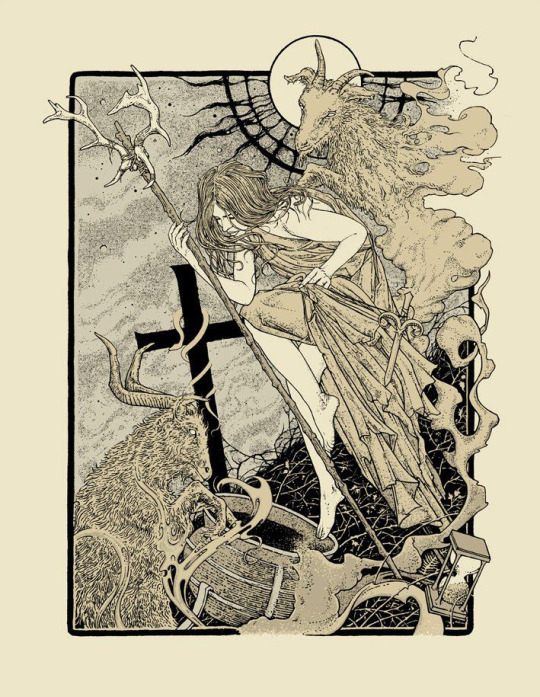
Glyn Smyth
20 notes
·
View notes
Text

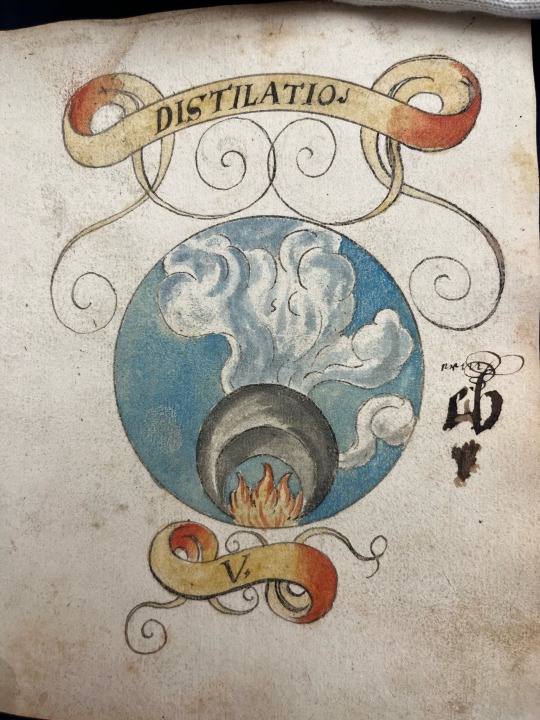



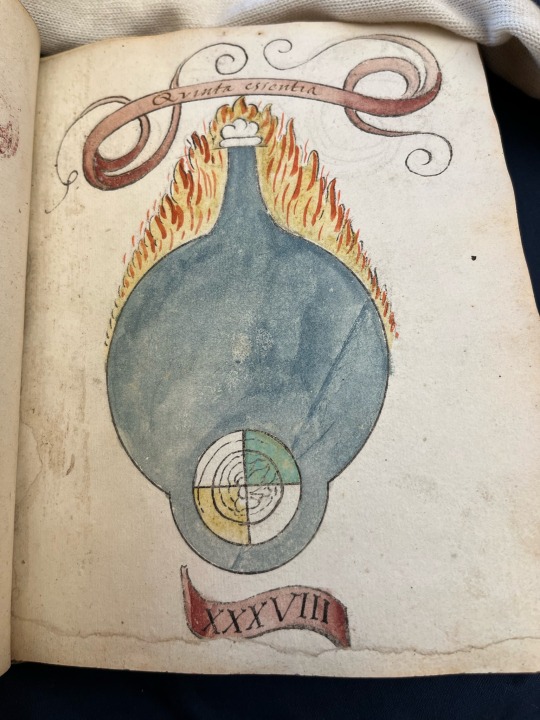
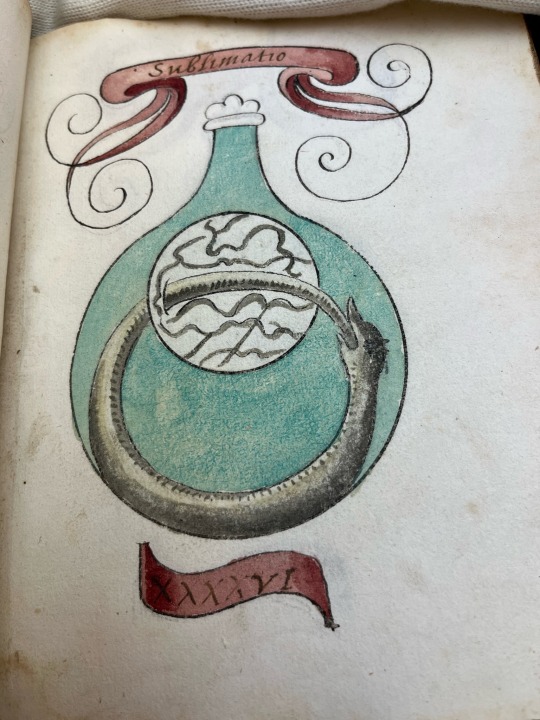

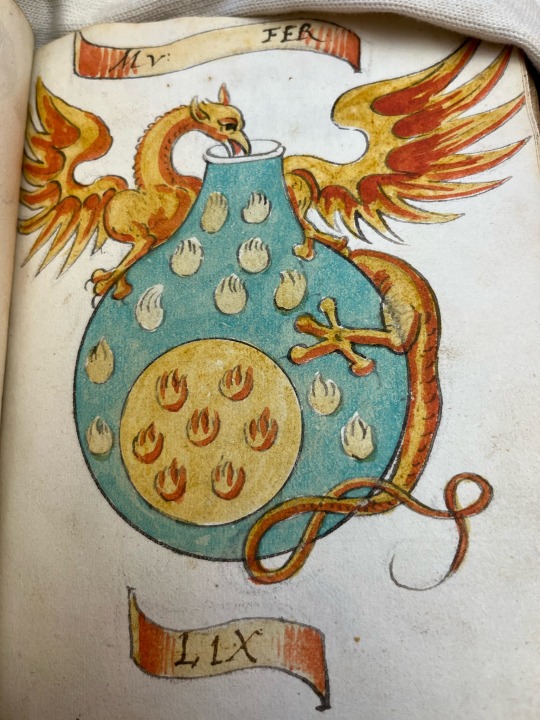
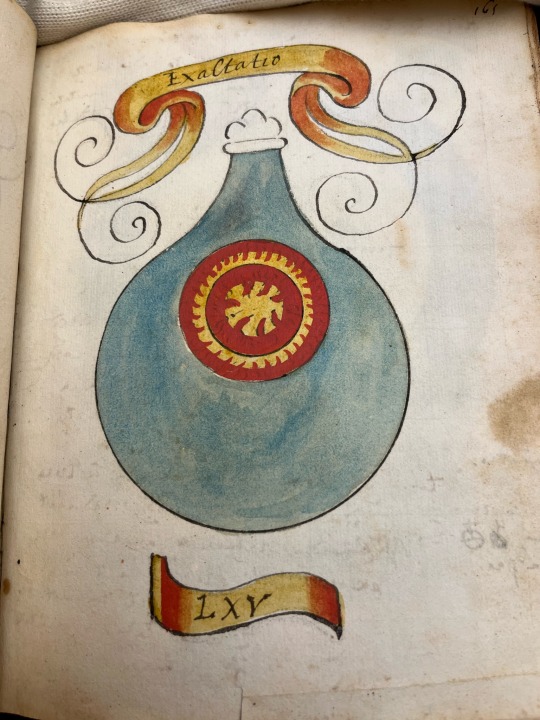
A selection of images from a sequence depicting the alchemical process, from an early modern manuscript.
#alchemy#alchemical#alchemical symbolism#alchemical art#occult#manuscripts#manuscript#medieval studies#early modern#renaissance
807 notes
·
View notes
Text

Art by Lucas Garcete
#darkart#poetry#moon#macabre#fantasy#vampire#vampyr#dark#dark fantasy#darkartist#gloomy#gloomy art#dark art#horror#horror art#artists on tumblr#photographers on tumblr#film photography#filmisnotdead#dark photography#symbolism#surrealism#art#digital art#lucasgarcete#plague doctor#night#moonlit#occult#demon
404 notes
·
View notes
Text



Wanted to join in on @ratblazer's DTIYS challenge for Johnstantine's upcoming b'day! I'm doing a Hellblazer marathon read so the timing couldn't be any better~ this was really fun!
#john constantine#dc comics#vertigo comics#hellblazer#my art#jl remix#on a hellblazer binge because that's apparently what I do the minute I learn a character's a twin#snuck in the number 4 among the fake occult symbols because im chinese and think that's funny
199 notes
·
View notes
Text
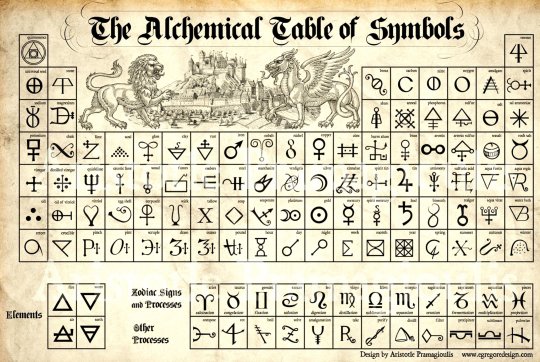
372 notes
·
View notes
Text

Art by Lucas Garcete, Contemporary love
#darkart#poetry#dark#dark fantasy#darkartist#gloomy#gloomy art#dark art#horror#horror art#artists on tumblr#photographers on tumblr#film photography#filmisnotdead#dark photography#symbolism#surrealism#art#digital art#lucasgarcete#night#moonlit#occult#darkcore#creepycore#terror#terrorart#surrealist art#surreal art#contemporary art
107 notes
·
View notes
Photo

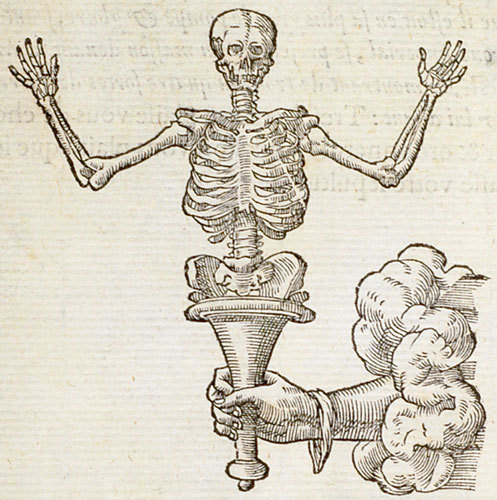



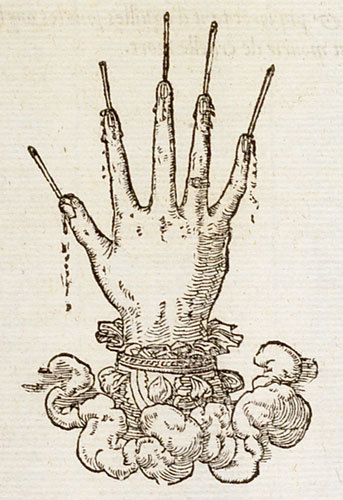
Claude Paradin's Devises heroïques, 1557
2K notes
·
View notes